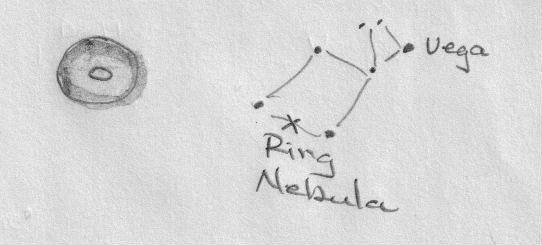Constellations: Boötes, Capricornus, Cassiopeia, Lyra, Ursa Major, Scorpius
Asterisms: Kemble's Cascade
Stars: Arcturus, Capricornus β1 & β2, Capricornus δ1 & δ2, Lyra Epsilon 1&2, Lyra Zeta 6&7, UMa 79, UMa 80
Messier Objects: M4, M20 (Trifid Nebula), M21, M22, M24 (Sagittarius Star Cloud), M25, M57 (Ring Nebula)
Location: St. Croix Observatory (SCO)
With Others: Chris Young, Dave Chapman
Date: 2016-09-14
Time: 9:00 - 11:00 PM ADT
Transparency: Very Good
Seeing: Very good
Temperature: 11.5° C
Obtained a ride from Dave Chapman and Chris Young to head off to SCO whereas hubby headed to St. Margaret's Bay for a timelapse session. Windy at first at SCO and then stopped.
M4: (NGC 6121)
Time: 9:45 PM ADT
Equipment: Binoculars 10x30 IS
Magnification: x10
S&T Chart Ref: 56, 58
Chris Young provided guidance on how to find it. Antares was located low in the sky with Mars and Saturn nearby. The grey circular fuzzy was seen with averted vision at approximately 5 o'clock from Antares.
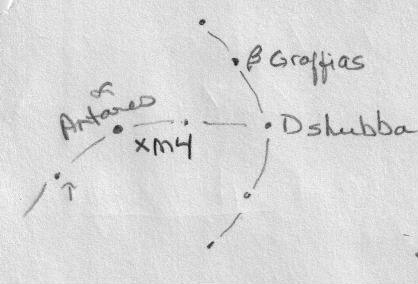
M20 & M21:
Time: 9:45 PM + 11:37 PM ADT
Equipment: Binoculars 10x30 IS + Thurlow Binoculars
Magnification: x10 + x20
S&T Chart Ref: 67, 69, I
Initially used my binoculars but then used the Thurlow Binoculars with Chris Young's assistance. We were able to clarify the boundaries between M20 and M21. It was much easier with the Thurlow's x20 magnification to make that distinction.
Boötes:
Time: 9:52 PM ADT
Equipment: Visual
S&T Chart Ref: 42, 44, 53, 55
Thanks to Chris Young for identifying this and showing me how to find it by following the arc of the Big Dipper's handle ("arc to Arcturus") then looking for the necktie/kite shape of the constellation. Noted it was adjacent to Corona Borealis and was tilted away from it. Identified stars in the constellation.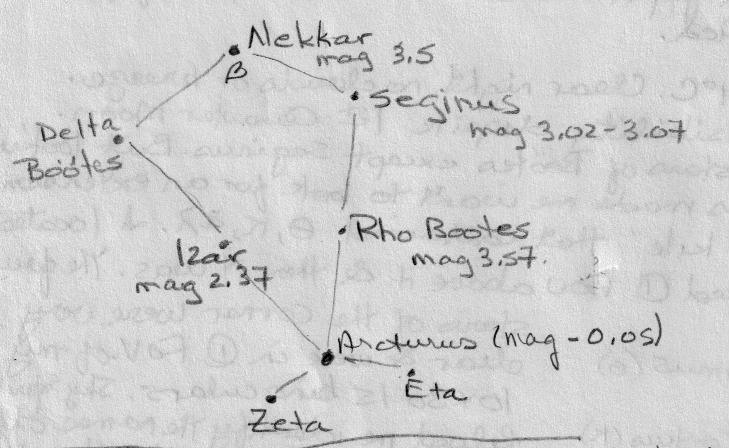
M22, M24, & M25:
Time: 10:22 PM ADT
Equipment: Binoculars 10x30 IS
Magnification: x10
S&T Chart Ref: 67, 69, I
Chris Young and I wanted to get a better sense of location, size and boundary in relation neighbouring Messier objects. We found all 3 objects with our binoculars and had no difficulty in doing so.
To find M22:
It was easy found with Kaus Borealis at about 5 o'clock in the boundary of my FOV, then moved the eyepiece a little NE to view a small Y-shaped asterism with M22 to the left of it. The circular cluster was denser in the centre and fairly bright. Didn't draw the stars in it.
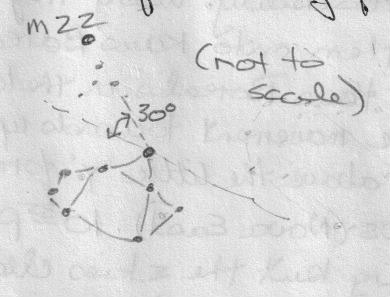 |
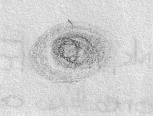 |
To find M24: (Sagittarius Star Cloud)
Time: 10:40 PM ADT
Equipment: Binoculars 10x30
Magnification: x10
S&T Chart Ref: 67, I
We followed the line from Kaus Australis to Kaus Media in the Teapot, then went up 2 twice that distance. We saw a very dense star field that I couldn't fit not 1 FOV.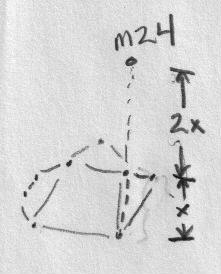
To find M25:
Time: 11:10 PM ADT
Equipment: Binoculars 10x30
Magnification: x10
S&T Chart Ref: 67, I
Found a dim patch of diffuse light. Couldn't make out individual stars very well at all. Thanks Chris Young fo helping locate this one!
Lyra:
Time: 11:00 PM ADT
Equipment: Visual + Binocular 10x30 IS + 16" Newtonian Reflector with 8mm eyepiece, f1800, x225 mag
S&T Chart Ref: 63
Thanks to Chris Young! Located Vega then the parallelogram below it visually. All 4 stars of the parallelogram were easily identified but they were pale compared to Vega.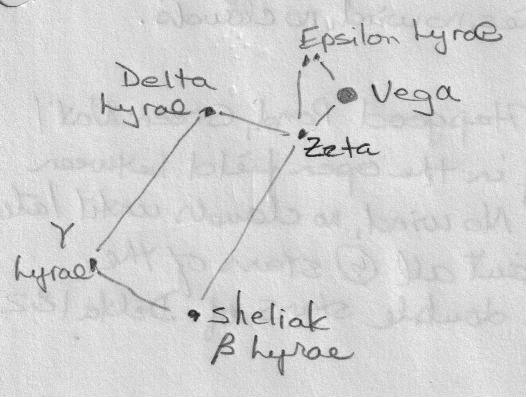
Lyra, Epsilon1 and Epsilon2:
Time: 11:00 PM ADT
Equipment: Binocular 10x30 IS + 16" Newtonian Reflector with 8mm eyepiece, f1800, x225 mag
S&T Chart Ref: 63
Chris Young and Dave Chapman then wanted to show me Epsilon1 and Epsilon2 using binoculars and SCO's 16" reflector telescope.
a) Binoculars: Looke for Vega then moved to Epsilon. Separation was evident albeit blurred.
b) Telescope: Found it in the finder scope, then had to move it slightly to see the "double-double". The pair on the left was horizontal; the pair on the right was vertical.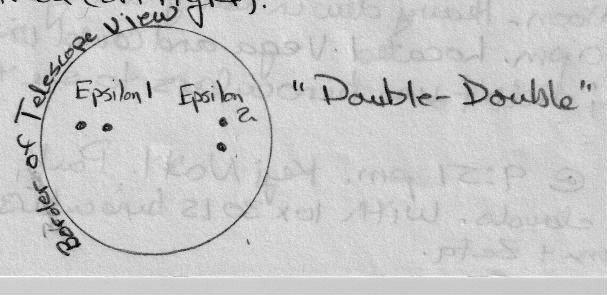
Lyra, Zeta1 and Zeta2:
Time: 11:10 PM ADT
Equipment: Binocular 10x30 IS + 16" Newtonian Reflector with 8mm eyepiece, f1800, x225 mag
S&T Chart Ref: 63
Found the triangle earlier in the evening with binoculars. Zeta1 and Zeta2 were not sen with binoculars but were viewed wth the telescope. First found it in the finder scope then slightly adjusted it for the eyepiece.
Ursa Major - Alcor (79 UMa) & Mizar (80 UMa):
Time: 11:15 PM ADT
Equipment: Binoculars 10x30 IS + 16" Newtonian Reflector with 8mm eyepiece, f1800, x225 mag
S&T Chart Ref: 42, 44, 53, 55
a)Visual: Found Mizar and Alcor plus a 3rd faint star to the left that would form a triangle, just as I had seen the night before eat the Swiss Air Monument.
b) Binoculars: Found the 2 stars plus a dimmer smaller star to their left to forma triangle.
c) Telescope: I was shown Mizar in the telescope, then was made to find Mizar A and Mizar B using the telescope without the go-to capability. I was able to find them; they were close together with Mizar B located about 4 o'clock to Mizar A.
Kemble's Cascade:
Time: 11:30 PM ADT
Equipment: Visual + Binocular 10x30 IS
Magnification: x10
S&T Chart Ref: 11, 13
Thanks to Dave Chapman who introduced this to me.
a) Visual Location: Found Cassiopeia. Drew an imaginary line from Beta to Epsilon, then extended the line the same distance from Epsilon. Saw a faint bright line extending southwards towards the horizon.
b) Binoculars: Put my binoculars up to see what I thought was the start of the Cascade. Saw 4 bright stars in almost a straight line then the multiple well-spaced stars in a cascade towards the horizon and then terminated in stars arranged like the end of a hockey stick. A much brighter star half way down.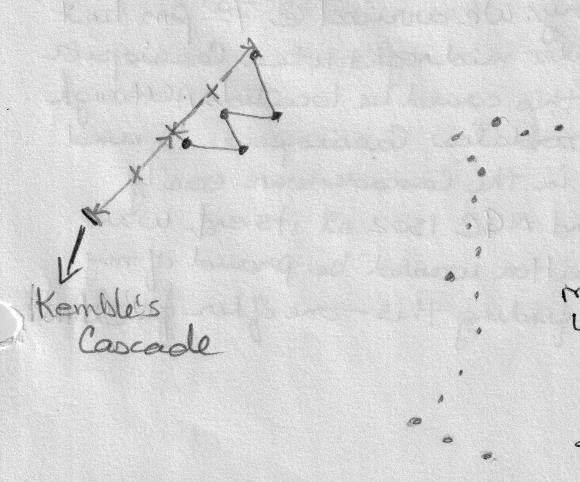
Capricornus - β1 & β2, δ1 & δ2:
Time: 11:40 - 11:50 PM ADT
Equipment: Visual + Binocular 10x30 IS
Magnification: x10
S&T Chart Ref: 66, 68, 77
Dave Chapman agreed to help me find the two sets of double stars in Capricornus - Delta1 and Delta2 plus Beta1 and Beta2. We found the constellation visually then located Delta Capricornus that appears as a single star. However, with binoculars, 2 stars (optical double) appeared with one just slightly above the other. We then looked below them for Beta Capricornus (Dabih). Again 2 stars were visible at this location, one brighter than the other. I failed to draw or explain in my rough notes the relationship of these two stars.
M57: (Ring Nebula)
Time: 11:47 PM ADT
Equipment: SCO Skywatcher 16" Dobsonian, 8 mm eyepiece
Magnification: x225
S&T Chart Ref: 63
Couldn't see this visually with binoculars. The telescope showed a donut-shaped object, more dense on the outer edge and less dense as went closer to the centre opening. NOTE: Also saw this Aug 26/16 at Nova East using mark Dryden's Obsession telescope.
